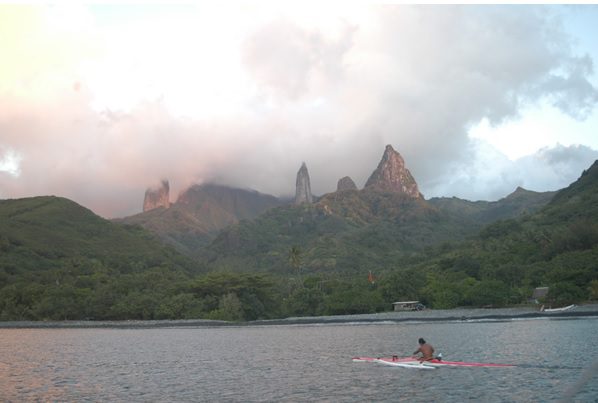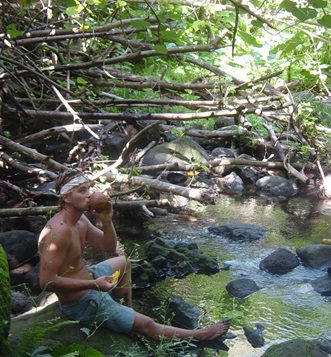No Cheeseburgers in Paradise
Thursday May 20, 2004
Hakahetau Bay
Ua Pou , Iles Marquise
S 09o 21.489 W 140o 06.382
Tonight Lillian is the only boat anchored in a shallow harbor off the small village of Hakahetau on the island of Ua Pou. Seven monolithic basaltic rock towers, the tallest nearly 4000 feet, provide the backdrop for the town. As is typical, the land of the village is wedged between two hills that rise steeply from a deep blue ocean. Near the waterfront is a bit of flat land that has simple facilities for soccer, volleyball, and lawn bowling. In the afternoon and early evening, this park was filled with activity.

When Peter and I first rowed up to the cement quay at the east side of the harbor, one of the women helped guide us in and offered her hand as we got out of the boat. She welcomed us, and asked where we had come from and how long we were staying. After thanking her, we walked up the single road running through the town. As is typical of these villages, there were no cafes, no restaurants, and no souvenir shops, only a single “magasin” with limited canned goods. In the Marquesas, other than the occasional offer of fish, wood carvings or tapa, there seems to be little or no entrepreneurial spirit.
Back in Equador, literally within minutes of our arrival in Puerto Ayora, Galapagos, a young man had motored out to the Lillian B. and offered to procure diesel, clean the boat, and provide whatever other services we might want. In the town itself, there were numerous shops, bars, and cafes vying for the cash of foreign visitors.
In the Marquesas, there is virtually no catering to tourists. The excellent French bread, much in demand, is price controlled and sold out by 9 am. On the island of Hiva Oa, which has the second largest Marquesean city of Atuona, the only diesel depot on the island was out of fuel for over a week and a half. In Taiohae, the largest city of all the islands, there is no “hangout” for the hundreds of yachties sitting on their boats in the bay, with money in their pockets, wondering where to get a beer and a good meal.

I suspect this lack of entrepreneurship has been cultivated by the French government through subsidies and regulations. To visit the Marquesas you have to first fly to Tahiti, nearly 800 miles away. Sailboats are the exception, being able to enter French Polynesia directly in the Marquesas. Despite their beauty, there appears to be no promotion of these islands either locally or internationally. In the US, it is nearly impossible to obtain travel information concerning the Marquesas. Perhaps in France it is different.

The Marquesians seem to be content with their standard of living, with no motivation to change the status quo. According to one Pension owner, taxes are very low. In addition, there is a disproportionate amount of material goods on these islands. Television is beamed from island to island via antennas high on the hillsides. Phone booths can be found along isolated paths. Roads are well maintained despite difficult mountainous terrain. On Fatu Hiva, where the only road on the island is no more than ten miles long, many of the villagers have new four wheel drive vehicles sitting in their driveways. The source of income required to pay for those vehicles is no where evident.
It is as if the French government has determined to keep the Marquesas as unchanged and as un-commercialized as possible. Perhaps the motivation springs from a desire by people of influence to keep paradise a secret. Or, perhaps the motivation is indeed altruistic, with a sincere desire to preserve a culture. Whatever the motive, I have to admit that I am selfishly grateful to be sitting in a starlit harbor, looking at the shadow of mountainous columns of rock looming over a dimly lit village, without a glaring set of yellow arches within a 1000 miles.
